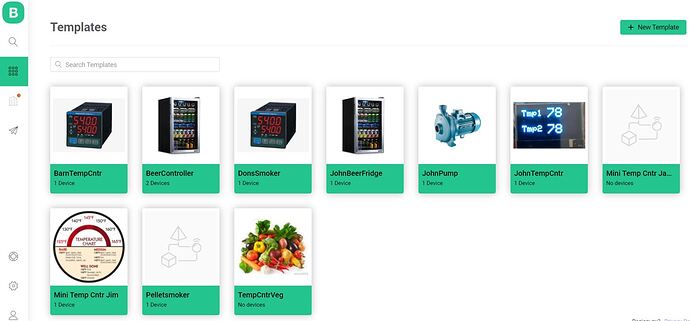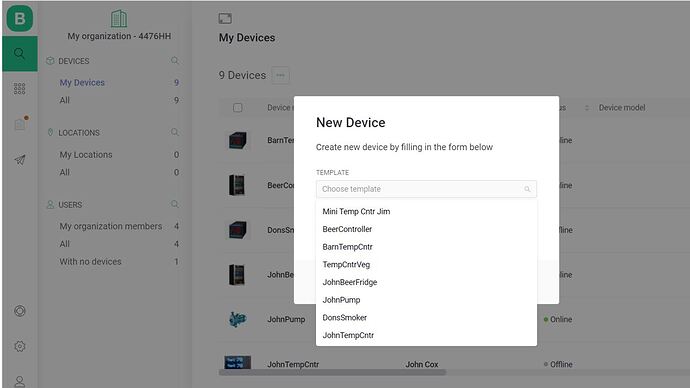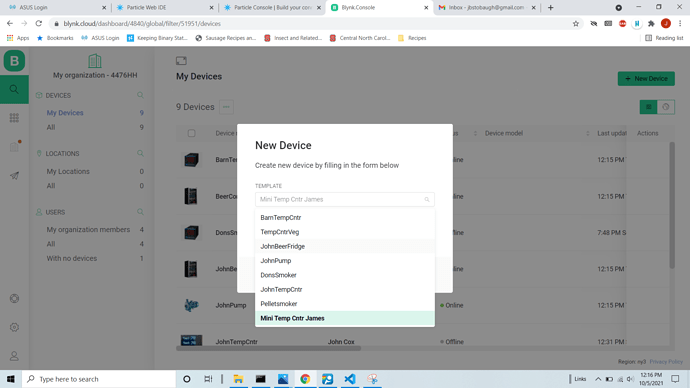terminal has not been repaired
It’s not a bug. It’s a feature that is not yet implemented.
I don’t understand what is meant by a feature that hasn’t been implemented
The Terminal widget in Blynk Legacy had a feature which allowed it to retain and re-display the data that had previously been written to the widget before the app was closed.
This generally worked okay, but with a few hiccups along the way.
This feature has not yet been implemented in the Blynk IoT version of the Terminal widget, presumably because the developers are looking at a better way of doing it compared to Legacy.
Therefore, the lack of ability to display this old data isn’t a bug (unexpected or unexplained behaviour), it is how the widget is currently designed to work, because this feature has not yet been implemented.
Pete.
Thank you Pete for the clarification
Here is where I detailed the wifi connectivity issue. Blynk app fails using Wifi mesh network - #13 by jstobaugh I will be out for a week but will try and follow up on the other issues when I get back.
Here is examples of other bugs. I created a Template called MiniTempCntrJames as seen below.
I then go to the device screen to add a device and use that template. It doesn’t show up as available. I found the bar isn’t showing up that allows to scroll downwards for the rest of the devices. A refresh the first time allows you to see the scroll bar.@jstobaugh thanks, we weren’t able to reproduce the issue. Please try to clear the browser cache, there is a small chance you have old scripts cached.
@Dmitriy and @Pavel I still thinking Blynk team could make it more simple for everyone. In my eyes, the best approach would be to go straight from Free to Pro, scrapping the Plus plan altogether.
Then make the Pro plan scalable by adding more devices/users as necessary. New comers would benefit from FULL Blynk resources. The point is that Blynk is not offering a good scalability option today from the Business standpoint. Those that can use 100% of PRO capacity will say the plan is fine as it is today. The real problem is with the new business that don’t want to pay for a Pro in the beginning and waste all the remaining capacity that PRO plans offers (this doesn’t make sense for anyone that is just starting a new business).
Apologies for the length of this post. But I have been a passionate Blynk user for the last 6 years. Wasted so many hours on it ![]() . It would be a misspent youth if I was still a youth.
. It would be a misspent youth if I was still a youth.
This post is to do with the change in pricing structure as per my last post and @Dmitriy comment about having a look at it again. I will get back to this point once I’ve said my piece.
I’ve now spent some time investigating the migration from legacy to 2.0 Blynk. 2 devices out of my 25. I am ready to migrate the remaining devices but not with the existing price structure.
My feedback? It is a case of the good the bad and the ugly.
I am almost hesitant to repeat the general feedback about the migration on this forum but I do need to get it off my chest and who knows the weight of discussion might just get things changed. That’s of course if Blynk really still do value the customer base that helped them on their way. But I’ll accept it if Blynk don’t and I will move on. It’s a commercial world and this won’t be the first time. Pachube is dead– long life Pachube.
The good: I suppose some of the existing widgets and new widgets are better. I’m sure the under the bonnet stuff is better, more secure, more robust and scalable. Bit like the migration from Windows 3.1 to NT back in the 90’s. Some of the ways of developing are better – albeit better for the commercial/white label guys. Easier centralized command and control.
The bad. Initial user interface – tiles. I am a big user of legacy tiles. But without the facility (as far as I know – correct me if I am wrong please) to organize the tiles (alphabetical, grid pattern, groupings on more than one page) then the user interface is not as good as legacy Blynk. Lack of some legacy widgets e.g. For me the device selector was so efficient. Bridge I have replaced with the API anyway as it used to crash my ESP’s. Thank you for bringing back the time input. Please don’t remove it. It works. It’s not broken. It doesn’t need fixing.
The ugly. The recently changed pricing structure. Users, devices and the artificial limit on the number of widgets. Pages also but that’s a new feature so I can’t grumble whereas having unlimited widgets reasonably priced is not a new feature. I thought we had moved away from the energy concept but limiting widgets per plan is similar to buying energy.
What do I suggest? What would let me move on? Simply revert to the 3 pricing structures you had before (or at least a more economical growth path) until it was hastily removed before things had settled down.
Well for what it’s worth I’ll add this to the almost infinite number of suggestions. Just my opinion. I know you have not asked for it but here it is free of charge.
-
Generically there are 3 types of users with variations between them. This is the general case – not just specific to Blynk. You have to have boundaries between them and that’s the challenge. Find the boundaries.
-
Firstly the simple dabbler just starting out. Student etc. Secondly the annoying nerd who has nothing better to do (me
 ) and thirdly the Commercial guys who will use the platform to sell and make money – maybe
) and thirdly the Commercial guys who will use the platform to sell and make money – maybe  .
. -
You have it right for the dabbler. 2 users & 2 devices. Simple & free. The appetite will come with the eating and no skin of Blynk’s nose to accommodate (just poor @PeteKnight who has to deal with our inane questions and code not properly formatted). Loss leader.
-
The nerd. Has no interest in going commercial. All devices are on the home network. Wants maybe up to 5 users. Maybe up to 30 devices (why? – because he was able to, did and has). More than 80 widgets per device – 2 of mine had over 130 (why? Because I could, I did and I still have under legacy Blynk). No interest in provisioning, command and control, companies, sub companies, user rights etc. Price? For me and me alone as an example: Max 5 users. Max 30 devices. No limit on widgets – seems punitive for no good reason. Monthly subscription $5-10 – it’s the general price range for most IoT for no good reason. We’re used it. It’s seems right and a no brainer. It’s the variable cost. Then one off fixed cost per device $5-10. Maybe in bands of 5. After all, my device ESP8266 is $5 with ESP32 at $10-30. So it’s in the order of magnitude the same and a no brainer.
-
Commercial. More like 1-1 ratio of devices and users. Command and control. I don’t have a view on the price structure other than it’s not for me and I won’t go there just to get more than 80 widgets and more than 10 devices.
I wait with bated breath – but not for long. My youth is fast running out and I have a limited amount of old age misspending left to do.
I agree with koaiwi.
I would jump on for 5-10 USD/month if I got:
- 30-40 devices
- Few users (5 ok)
- Possibility to buy more devices one-off. (You always want “just one more”…)
- Several devices in same mobile project
- More flexible data widgets in mobile dashboard. Currently you can display max 3 values. I’d like to show graphs, gauges, etc also.
- Perfectly Ok if you provide “restrictions” so I can’t use it commercially. Limiting to few IP addresses per day etc. (Just example. I have no idea of good solutions.)
With this, I’d pay 5-10 USD/month.
Then I could also wish for:
- Room or other section/region grouping of devices. Currently Blynk is very “device oriented” (and more so with Blynk IoT). I’d prefer more “location oriented”. I prefer to see temp in Bathroom and start fan in Bathroom rather than see temp on device 3 and start fan on device 4. Devices need to be grouped in rooms or areas or regions.
My interest of Blynk is (strictly) from a private home automation builders view. I want to automate my 2 homes. I have used Blynk Legacy as the central for this. Blynk IoT is partly moving away from this.
Blynk IoT for me is more towards companies and enterprises providing no-cheap electrical appliances with a need for app-control. Not for controlling 10 - 20 (cheap) lamps in a house, but more to control a few or a single (more expensive) devices. And distribute the apps/logins. And for more “fleet management” (which how is see the web dashboard is aimed for).
As I see it.
I hope Blynk can cater both for Home makers (hobbyists) and Companies/Enterprises.
Home maker/hobbyist: Lots of different devices to control a house or similar.
Company/Enterprise: Hundreds and Thousands of customers with 1 or few “same/similar” devices. Heaters for example. Distribution and activating devices and accounts are important.
Different needs. Partly.
I hope we both can get what we want to an appealing price.
Jonas
Edit:
Just also want to say. I have been testing new Blynk IoT for a week+ now and I do like many new features and design ways. The product is good and something I really want.
Main concern is too expensive for me with 13 devices (and wanting more) and lack of possibility to have several devices in one mobile “project”. (I just can’t display info from 5 different sensors/devices in one view. This is a “drawback” to me. )
Hi Pavel, can you please clarify some terminology here? For some reason I can’t get my head around the new pricing model terms like “user” and “devices” in the Blynk context. My application is relatively simple I think: up to 100 devices (all the same HW) and up to 100 users (that is, each device will have 1 user). The usage is non-commercial IoT, students doing mobile air quality sensor measurements. Which plan is best? Thanks for a great product!
We don’t have a solution for schools and universities at the moment. The best approach would be for every student to create their own account and work there.
So many feedbacks saying the same thing that a Better scalability is needed. I just don’t understand why Blynk team is ignoring it…
We don’t ignore it. It was heard and will be considered.
So my advice is that you follow-up this important topic and keep your customers updated about what you are planning to consider. I pointed out many considerations in another thread. No feedback from you. I see many people complaining the same (customers from Legacy, including). If it is so important for many of us, you should find a way to provide a better and fast feedback about it.
@Hugo-BR let me remind you that we don’t have to do anything. We build a product you may decide to use or not. Your demands in such a tone have no ground.
@Pavel I totally agree with you. However, chances of boosting business up with successful organic growth are quite often linked to benchmarking and most important, understand the real customer needs. But it is your call the way you define this strategy, not mine. Just my point of view.
We need a pricing plan for 20 devices. I hope to work on it. I automate several companies. Each company has 20 devices or less. I buy a pluse plan for each company on their own account, and they pay blynk every year, but the pluse plan is not enough and the pro plan does not suit the company.
We are considering expanding plus plan with more devices option.


